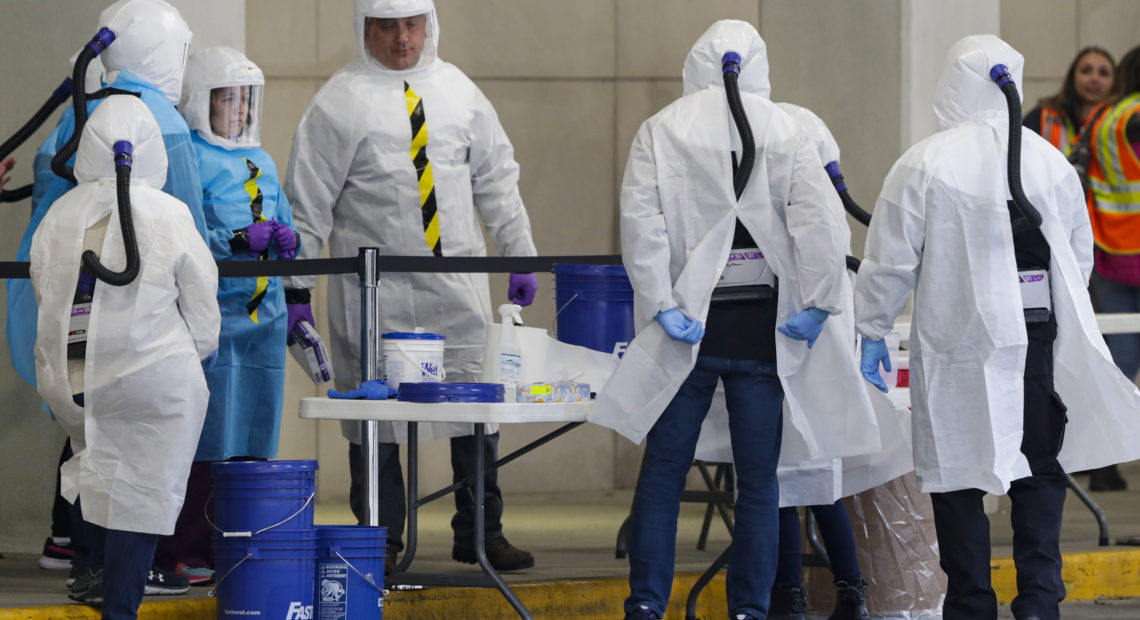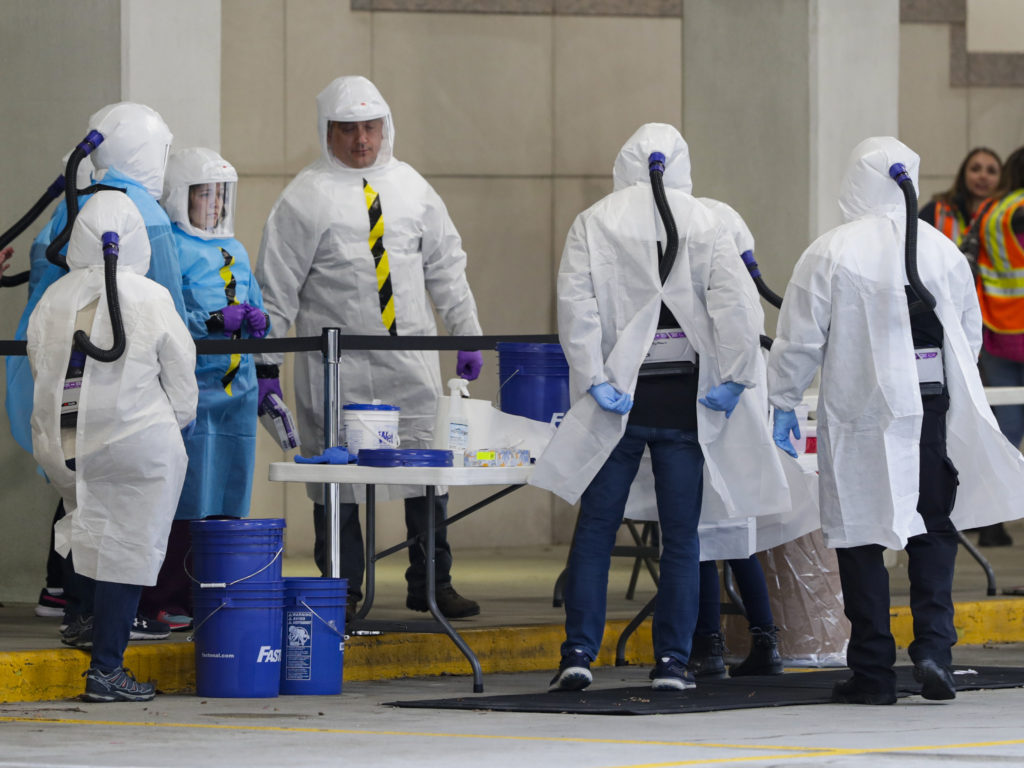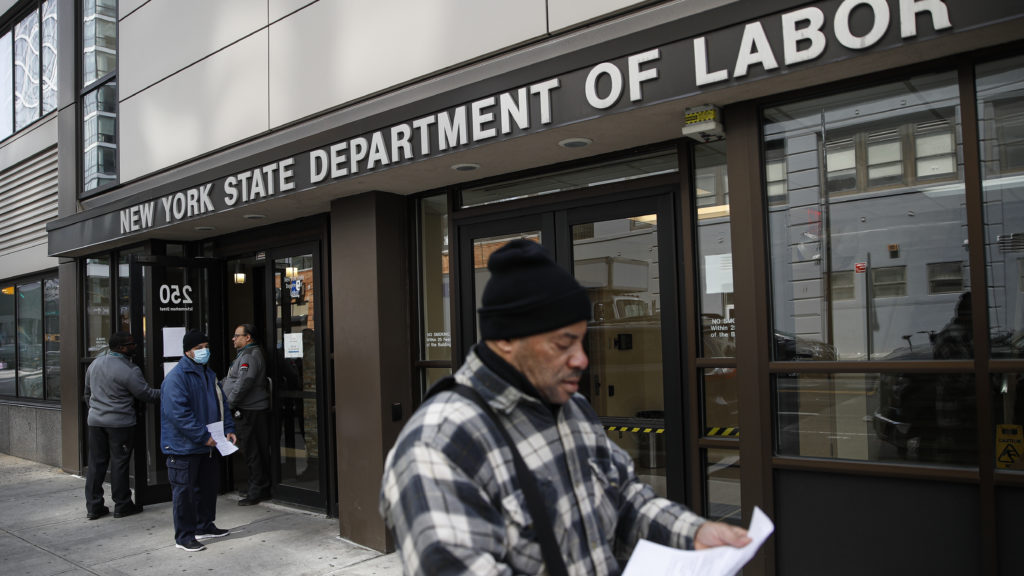
Could This Coronavirus Pandemic Reshape America’s Social Safety Net?
BY DANIEL BUSH / PBS NewsHour
The Democratic primary race was all but over before the novel coronavirus upended the 2020 campaign cycle last month. With former Vice President Joe Biden as the nominee-in-waiting, the only lingering question had been how far he might shift to the left to win over Sen. Bernie Sanders’ progressive followers before formally clinching the nomination.
But in the weeks since the pandemic brought traditional campaigning to a standstill, the national political debate has moved away from the narrow ideological battle on the left that dominated the primary season.
Now, Americans across the political spectrum have been forced to rethink the government’s role in protecting workers and supervising the economy, as more people confront a public health crisis that has exposed major gaps in the social safety net.

Economists say helping the health care sector, including through emergency financing to states and cities, is one of the steps urgently needed to weather the coronavirus crisis.
CREDIT: Michael Conroy/AP
“It was clear to people like Senator Sanders and Elizabeth Warren that we had these extreme vulnerabilities” long before the novel coronavirus, which causes the illness COVID-19, hit the United States, said Stephanie Kelton, an economics and public policy professor at Stony Brook University, and a senior economic adviser to the Sanders campaign.
“If you didn’t see them before, you see them now. People are dying,” Kelton said. The coronavirus is “bringing all of that to light,” she added. “We don’t have the robust social safety nets that many European countries have, and we pay the price for that.”
The global response to the pandemic has highlighted fundamental differences between nations with centralized, authoritarian systems of government like China, and countries such as the U.S., where the state has less control over individuals and businesses.
But the approach each country has taken to dealing with the pandemic has so far defied easy categorization.
China flattened the curve of the virus within its borders by instituting a strict lockdown in Wuhan, the city in Hubei province where the first cases of COVID-19 were reported. China also adopted other measures to contain the virus, including using technological surveillance tools to monitor individuals’ travel. Together, the steps represent the strictest social controls put in place by any country in response to the pandemic.
South Korea, a wealthy democratic state with a multi-branch government that resembles the system in place in the United States, curtailed its number of coronavirus cases without resorting to restrictions on civil liberties.
ALSO SEE: Coronavirus News, Resources, Updates From NWPB
South Korea succeeded in large part by implementing an early, widespread testing program that has become a model for other nations to follow. A second wave of cases in the country has underscored the challenges of preventing the virus from recurring after it has been initially contained. Still, South Korea remains a symbol of hope for curbing a pandemic that has killed more than 40,000 people worldwide.
Italy and Spain have struggled to curb the virus’ spread despite issuing mandatory lockdowns that are far more restrictive than the shelter-in-place orders adopted by governors in the United States. Italy has more than 13,000 deaths due to COVID-19, the most reported of any country.
The United States, in contrast, has more than 200,000 cases of infection to date — far more than any other nation — with roughly 5,000 deaths so far attributed to COVID-19.
President Donald Trump, who has drawn significant criticism for his handling of the crisis, said Tuesday the final death count could be between 100,000 and 240,000.
In comparison, the H1N1 virus, or swine flu, resulted in 12,469 deaths in the U.S. out of an estimated 60.8 million cases in 2009-10, according to the Centers for Disease Control and Prevention. The 1957 flu pandemic killed more than 100,000 people in the U.S. But comparisons between the coronavirus and other viruses and diseases — including the seasonal flu — are flawed, since each illness has different rates of infection and mortality, and because the data on the coronavirus is still evolving and remains incomplete.
Overall, the U.S. response to the virus has clearly lagged behind other countries, argued Bhaskar Sunkara, the publisher of Jacobin Magazine, a prominent socialist publication in the U.S.
“Forget about China and these authoritarian states. We look poor compared to Germany and South Korea,” Sunkara said.
Sunkara and others on the left said they were pushing for more public support for reforms that could help the country weather an economic downturn or major crisis like the current pandemic, not for an immediate embrace of socialist-style rule.
“It’s not about growing the size of government, or making government more intrusive,” Kelton said. The United States should “have programs in place to help protect people, to catch them. That’s what you want the state to do, provide basic safeguards.”

Forecasters say the government’s aggressive efforts to slow the spread of the coronavirus will trigger the sharpest slowdown in the U.S. economy on record.
CREDIT: John Minchillo/AP
Some on the right have joined critics of the Trump administration in calling for improvements to the nation’s public health infrastructure. Republican lawmakers voted alongside Democrats last week to approve a $2 trillion coronavirus response bill that included provisions to aid hospitals treating coronavirus patients, as well as financial support for workers and companies. The bill also included a temporary expansion of unemployment benefits.
But the crisis has also laid bare long-running disagreements between liberals and conservatives about the size and scope of government.
Whenever the state plays a more active role, “there’s a trade off: personal freedom versus a government that’s much more intrusive and places many more restrictions on our lives,” said Lee Ohanian, an economics professor at the University of California, Los Angeles, and senior fellow at the right-leaning Hoover Institution.
“It really boils down to, how big of a social safety net do we want?” Ohanian said.
This debate predates the coronavirus pandemic, of course. A battle over economic reform played out during the Great Recession, when lawmakers and then-President Barack Obama fought over financial legislation aimed at reigning in Wall Street. In the early 1990s, Democrats and Republicans clashed over health care reform.
More recently, in the 2016 and 2020 Democratic presidential primary elections, Sanders helped lead the conversation around issues like universal health care and paid sick leave. His message may seem more relevant now in the time of coronavirus than it did just a few months ago.
“But it’s a conversation that has been going on for a hundred years in the United States,” said Ellen Fitzpatrick, a historian at the University of New Hampshire.
In searching for historical precedents, the Great Depression has become a popular point of comparison to the current crisis. Some economists and Trump administration officials have warned of Depression-era levels of unemployment that could set the U.S. economy back for years to come. In the last two weeks alone, roughly 10 million people filed jobless claims, a sign of how quickly the crisis has rippled through the economy.
Congress has already begun discussing another relief package. But there are differences between this crisis and the Great Depression that make it less likely Congress will approve anytime soon the kinds of sweeping, New Deal reforms President Franklin D. Roosevelt put in place in the 1930s.
ALSO SEE: Coronavirus News, Resources, Updates From NWPB
The initial crisis that led to the Great Depression — the stock market crash of 1929 — unfolded with astonishing speed, just as the coronavirus has spread across the U.S. seemingly overnight.
But by the time Roosevelt took office in 1933, the country had experienced three-plus years of severe economic suffering under President Herbert Hoover. Most Americans were angry with the ruling class for failing to turn the economy around, and frustrated that a promising new era of prosperity after World War I had somehow come crashing down.
“There had been such a widespread cultural celebration of business in the 1920s, and so much excitement about the stock market and new technologies,” said Kim Phillips-Fein, a historian at New York University. “One of the reasons the Depression was so shattering was that it really discredited the economic orthodoxy of the time.”
Public faith in unfettered, free-market capitalism “suffered a tremendous blow during the Depression. That sense of disillusionment made it possible for the New Deal to emerge as it did,” Phillips-Fein said.
Roosevelt used the political moment to create the foundation for the modern-day social safety net. A pillar of the New Deal legislation was the Social Security Act, which created a pension program for older Americans, an employer-funded unemployment insurance system, disability insurance, and a federal aid program for children from low-income families.
In addition to reshaping the federal government, the New Deal era also brought about a sea change in American politics. Among other things, it helped solidify the Democratic Party’s popularity with African American voters, creating one of the party’s most reliable voting blocs. It also paved the way for the Great Society reforms under President Lyndon Johnson in the mid-1960s, which included the creation of the Medicare and Medicaid programs in addition to landmark civil rights legislation.
Today, Americans appear just as frustrated with the establishment as they were at the start of the Roosevelt presidency. The public’s approval of Congress has remained below 30 percent for the past decade, for example. But the pandemic has not yet raised widespread doubts about the underlying soundness of the economy.
In his daily briefings on the White House’s coronavirus response efforts, Trump has frequently claimed, without evidence, that the U.S. economy was at an all-time high before the outbreak. The president has also repeatedly predicted that the economy will bounce back quickly once the virus is defeated.
Democratic leaders have argued that the Trump era economy is benefiting wealthy Americans, while leaving low-income and middle-class workers behind. Biden has signaled that, as his party’s nominee, he would make the general election in large part a referendum on Trump’s economic record.
That strategy may still work. Trump’s overall approval numbers could go down by the time of the general election in November, especially if the outbreak hasn’t been contained by then and the unemployment rate remains high.
But for now, whether or not the public believes all of Trump’s claims, many people still support his overall approach to the economy. According to a recent PBS NewsHour/NPR/Marist poll, 51 percent of adults approved of the president’s handling of the economy, though the results broke down along party lines.
And so far, there are no signs the crisis is leading to a national, bipartisan consensus for major social and economic change in the near-term.
Americans have gone along with state bans on large gatherings and other measures that have disrupted the economy. But the public’s patience will wear out, Ohanian said, and the faster the pandemic is contained, the less appetite there will be for large-scale reforms down the line.
“People will understand it’s an extreme situation, similar to a war in which the government must play a much bigger role in our lives” for a limited period of time, he said. “How long will they go along with this is another question, and how much economic uncertainty can we endure?”
Advocates pushing for long-term solutions will likely have to wait while the country continues grappling with the crisis at hand, the historian Fitzpatrick said.
“I don’t think that sort of beating that drum right now is going to get much of an audience,” she said. The immediate public health and economic threats posed by the coronavirus “are going to be occupying people’s minds.”
ALSO SEE: Coronavirus News, Resources, Updates From NWPB
Sunkara, the publisher of the left-leaning Jacobin Magazine, said he doubted the pandemic would spark “some radical turn in consciousness” by a majority of the U.S. population. But he nevertheless expressed cautious optimism that the crisis could eventually lead to new thinking about health care and economic policy.
Others said they simply wished the pandemic would lead to a broader agreement on the basic functions of government.
“What I hope comes out of this is not so much necessarily a consensus” on any particular plan or proposal, said Richard Frank, a health care policy professor at the Harvard Medical School, “but rather a commitment that we need to protect all of our people.” Frank added, “there are a lot of ways to do it and let’s debate that, but let’s agree that the government has a role.”
Copyright 2020 PBS NewsHour. To see more, visit pbs.org/newshour















